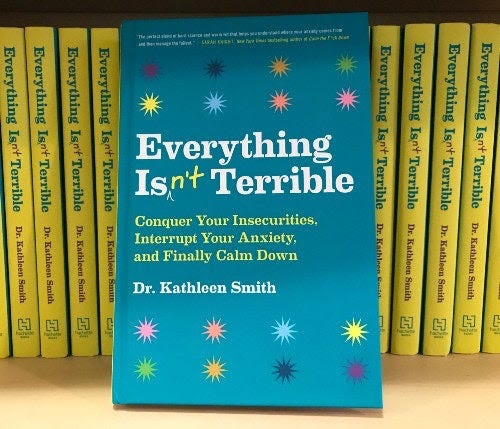What if your love language. . . is your anxiety language?
Gary Chapman’s book The 5 Love Languages has been a constant bestseller for years. People seem to like the idea that the root of marriage problems is a disconnect in how we express love (i.e. one person speaks “words of affirmation” while the other speaks “acts of service”).
Perhaps this is true, but when people come to therapy, I tell them that I’m very interested in learning about their anxiety language. In other words, the automatic ways that relationship systems manage anxiety.
How do you keep things calm in your relationships? How do you expect others to keep you calm? Because you might find there isn’t a disconnect at all—both parties are actively participating in a predictable pattern.
These patterns could look like:
One person does too much, and the other lets them.
One person withdraws, and the other anxiously pursues them.
Both people insist that it’s the other one who needs to change.
Both people worry about/complain about another person (often a child).
If one person in a relationship is willing to interrupt these patterns, then the whole relationship has to change. This means the work can start with you.
So what are your predictable responses when times are tense?
You might. . .
Need to be in charge to calm down.
Act more helpless than you really are.
Focus on how the other person needs to change.
Team up to worry about a third person.
Team up to complain about a third person.
Need constant reassurance to manage anxiety.
View compromise as “giving up” or losing.
Use another’s immaturity as an excuse to behave poorly.
Become allergic to another’s bad mood.
Need praise to believe you are successful.
Insist everyone do as you do.
Automatically view differences in thinking as threats.
Shift to more superficial conversation topics.
Hide your thinking so that you don’t upset others.
Need a third person to be a buffer.
Run to someone else to complain.
It is fascinating to observe how people in relationships will shift from one pattern to another. A conflictual couple may fight less when they’re both angry at the same person. A person who overfunctions at their job might abruptly quit, finding that distancing works just as well.
Here’s the good news. There are ways of being in a relationship that exist outside of these patterns. There are ways to be in a marriage without needing a kid to worry about. There are ways to be a leader at work without micromanaging everyone. There are ways to be in your family without needing a scapegoat.
Here’s the bad news. Abandoning your anxiety language is uncomfortable. We wouldn’t do what we do if it didn’t work pretty damn well most of the time. So are you willing to put up with some discomfort when you turn off the autopilot in tense situations?
Taking yourself off autopilot could look like:
Not immediately filling awkward silences with conversation.
Letting your spouse do the laundry a different way.
Letting your kid fail a test.
Compromising even if it feels like losing.
Not hurling insults back when insulted.
Talking about your own challenges instead of gossiping.
Fixing a problem even if others could do it for you.
Being honest even when criticized.
Calming yourself down even if your spouse will reassure you.
Letting other people be anxious.
Notice that I used the word “could.” People get frustrated with Bowen theory because the theory doesn’t tell you what to do. Differentiation isn’t about the response--it’s about how a response is activated. Is it a response rooted purely in emotion and not in reality? It is a response chosen to calm down the group or to piss them off? Or is it your best attempt to activate your own thinking when emotions are high.
When you begin to glide without your autopilot every now and then, a funny thing happens. You free yourself up to give and receive love with less pressure and more intimacy. Disconnects in “love languages” don’t really matter, because differences aren’t seen as threats. People are allowed to be themselves.
So this week, consider thinking about the automatic ways you manage anxiety, and how others participate in these patterns.
How do these rigid patterns keep people from being more responsible for themselves? From enjoying each other more?
How would shaking things up on your end make a relationship more anxious in the short-term, but more open, honest, and equal for the long haul?
News from Kathleen
Want to read more of my writing? I’ve started writing a weekly essay for Medium’s Forge Magazine.
I found out this week that Everything Isn’t Terrible will be translated into a 6th language! The Chinese and Polish editions are already out in the world, with more translations coming soon.
Buy my book Everything Isn't Terrible from Amazon, Barnes and Noble, Indiebound, or anywhere you buy books! Please consider supporting your local bookstore.
Get a free anxiety journal - Calming Down & Growing Up: A 30 Day Anxiety Journal includes thirty daily prompts to help you reflect on and respond to your anxious behaviors. To receive a copy, submit a copy of your receipt for my book at the Hachette page. Or you can email me.
Check out my website for past newsletters about anxiety and relationships.
Follow me on Twitter, Facebook, or Instagram, or email me if you have questions about my therapy practice in Washington, DC, virtual Bowen theory coaching, or having me speak to your group.
Visit the Bowen Center’s website to learn more about Bowen theory, as well their conferences and training programs.




I’d love to hear your take on the Ukraine invasion by Russia and it’s link to intersocietal anxiety and regression.